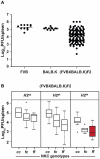NK cell receptor/H2-Dk-dependent host resistance to viral infection is quantitatively modulated by H2q inhibitory signals
- PMID: 21533075
- PMCID: PMC3080855
- DOI: 10.1371/journal.pgen.1001368
NK cell receptor/H2-Dk-dependent host resistance to viral infection is quantitatively modulated by H2q inhibitory signals
Abstract
The cytomegalovirus resistance locus Cmv3 has been linked to an epistatic interaction between two loci: a Natural Killer (NK) cell receptor gene and the major histocompatibility complex class I (MHC-I) locus. To demonstrate the interaction between Cmv3 and H2(k), we generated double congenic mice between MA/My and BALB.K mice and an F(2) cross between FVB/N (H-2(q)) and BALB.K (H2(k)) mice, two strains susceptible to mouse cytomegalovirus (MCMV). Only mice expressing H2(k) in conjunction with Cmv3(MA/My) or Cmv3(FVB) were resistant to MCMV infection. Subsequently, an F(3) cross was carried out between transgenic FVB/H2-D(k) and MHC-I deficient mice in which only the progeny expressing Cmv3(FVB) and a single H2-D(k) class-I molecule completely controlled MCMV viral loads. This phenotype was shown to be NK cell-dependent and associated with subsequent NK cell proliferation. Finally, we demonstrated that a number of H2(q) alleles influence the expression level of H2(q) molecules, but not intrinsic functional properties of NK cells; viral loads, however, were quantitatively proportional to the number of H2(q) alleles. Our results support a model in which H-2(q) molecules convey Ly49-dependent inhibitory signals that interfere with the action of H2-D(k) on NK cell activation against MCMV infection. Thus, the integration of activating and inhibitory signals emanating from various MHC-I/NK cell receptor interactions regulates NK cell-mediated control of viral load.
Conflict of interest statement
The authors have declared that no competing interests exist.
Figures






Similar articles
-
Multiparametric analysis of host response to murine cytomegalovirus in MHC class I-disparate mice reveals primacy of Dk-licensed Ly49G2+ NK cells in viral control.J Immunol. 2013 Nov 1;191(9):4709-19. doi: 10.4049/jimmunol.1301388. Epub 2013 Sep 25. J Immunol. 2013. PMID: 24068668 Free PMC article.
-
Distinct MHC class I-dependent NK cell-activating receptors control cytomegalovirus infection in different mouse strains.J Exp Med. 2011 May 9;208(5):1105-17. doi: 10.1084/jem.20101831. Epub 2011 Apr 25. J Exp Med. 2011. PMID: 21518798 Free PMC article.
-
MHC class I D(k) expression in hematopoietic and nonhematopoietic cells confers natural killer cell resistance to murine cytomegalovirus.Proc Natl Acad Sci U S A. 2010 May 11;107(19):8754-9. doi: 10.1073/pnas.0913126107. Epub 2010 Apr 26. Proc Natl Acad Sci U S A. 2010. PMID: 20421478 Free PMC article.
-
MCMV avoidance of recognition and control by NK cells.Semin Immunopathol. 2014 Nov;36(6):641-50. doi: 10.1007/s00281-014-0441-9. Epub 2014 Aug 21. Semin Immunopathol. 2014. PMID: 25141793 Review.
-
Natural killer cell licensing during viral infection.Adv Exp Med Biol. 2011;780:37-44. doi: 10.1007/978-1-4419-5632-3_4. Adv Exp Med Biol. 2011. PMID: 21842363 Review.
Cited by
-
Genetic dissection of NK cell responses.Front Immunol. 2013 Jan 18;3:425. doi: 10.3389/fimmu.2012.00425. eCollection 2012. Front Immunol. 2013. PMID: 23346087 Free PMC article.
-
Know Thyself: NK-Cell Inhibitory Receptors Prompt Self-Tolerance, Education, and Viral Control.Front Immunol. 2014 Apr 16;5:175. doi: 10.3389/fimmu.2014.00175. eCollection 2014. Front Immunol. 2014. PMID: 24795719 Free PMC article. Review.
-
Genome-Wide Exome Analysis of Cmv5-Disparate Mouse Strains that Differ in Host Resistance to Murine Cytomegalovirus Infection.G3 (Bethesda). 2017 Jun 7;7(6):1979-1984. doi: 10.1534/g3.117.042531. G3 (Bethesda). 2017. PMID: 28450376 Free PMC article.
-
Natural killer cell responses during viral infections: flexibility and conditioning of innate immunity by experience.Curr Opin Virol. 2011 Dec;1(6):497-512. doi: 10.1016/j.coviro.2011.10.017. Curr Opin Virol. 2011. PMID: 22180766 Free PMC article. Review.
-
Multiparametric analysis of host response to murine cytomegalovirus in MHC class I-disparate mice reveals primacy of Dk-licensed Ly49G2+ NK cells in viral control.J Immunol. 2013 Nov 1;191(9):4709-19. doi: 10.4049/jimmunol.1301388. Epub 2013 Sep 25. J Immunol. 2013. PMID: 24068668 Free PMC article.
References
-
- Guan H, Moretto M, Bzik DJ, Gigley J, Khan IA. NK cells enhance dendritic cell response against parasite antigens via NKG2D pathway. J Immunol. 2007;179:590–596. - PubMed
-
- Vankayalapati R, Garg A, Porgador A, Griffith DE, Klucar P, et al. Role of NK cell-activating receptors and their ligands in the lysis of mononuclear phagocytes infected with an intracellular bacterium. J Immunol. 2005;175:4611–4617. - PubMed
-
- Gonzalez VD, Landay AL, Sandberg JK. Innate immunity and chronic immune activation in HCV/HIV-1 co-infection. Clin Immunol. 2010;135:12–25. - PubMed
Publication types
MeSH terms
Substances
Grants and funding
LinkOut - more resources
Full Text Sources
Molecular Biology Databases
Research Materials
Miscellaneous

